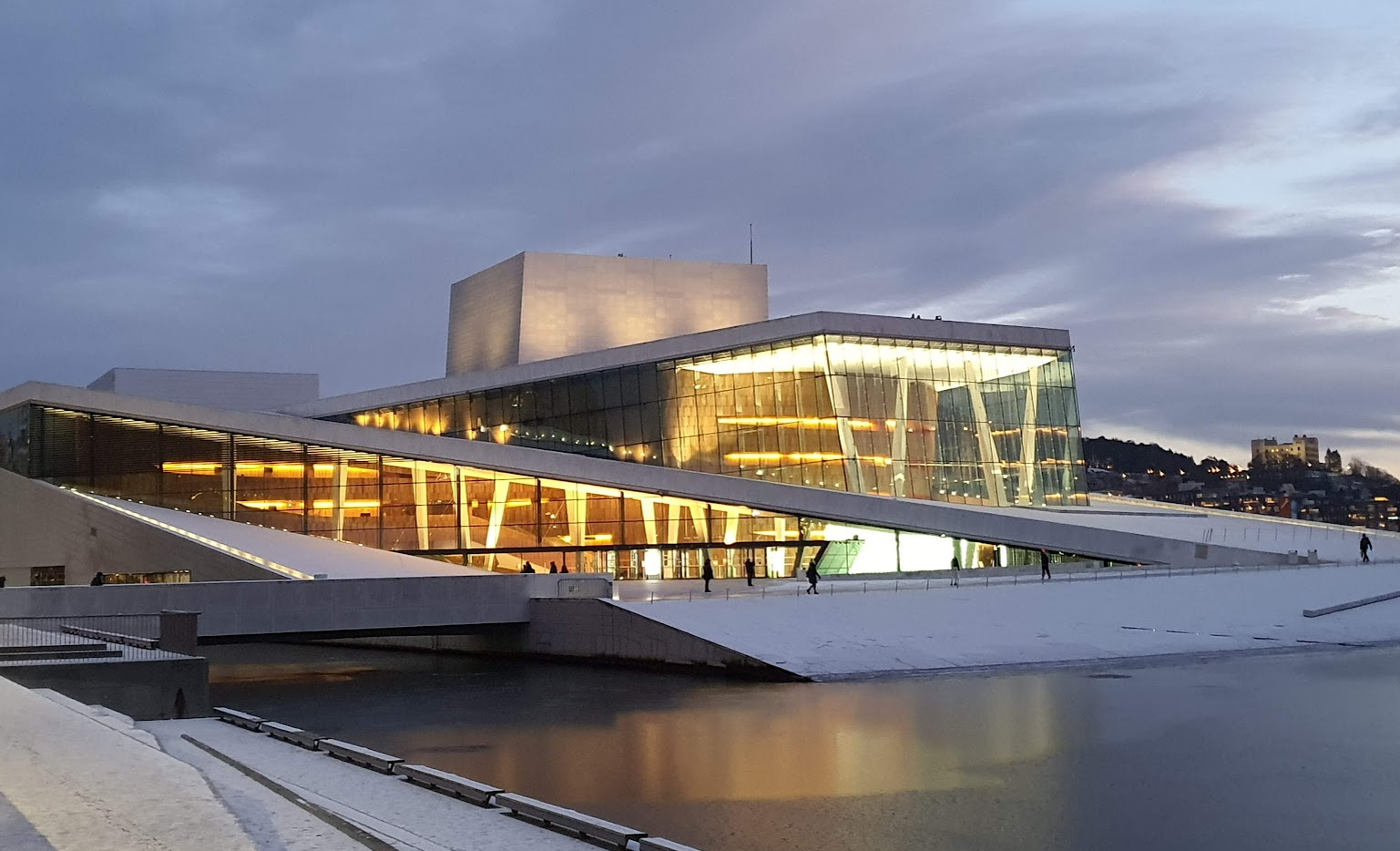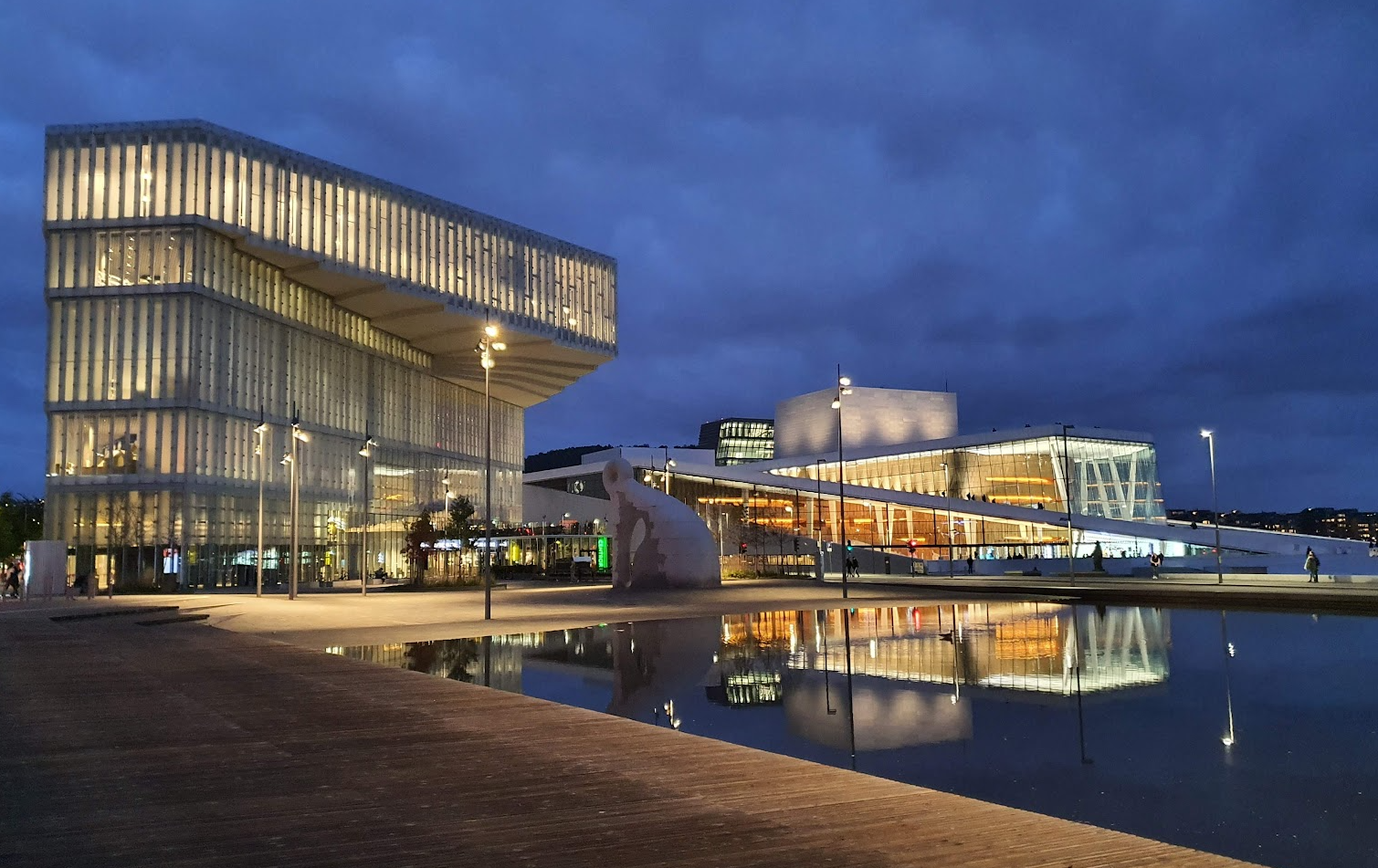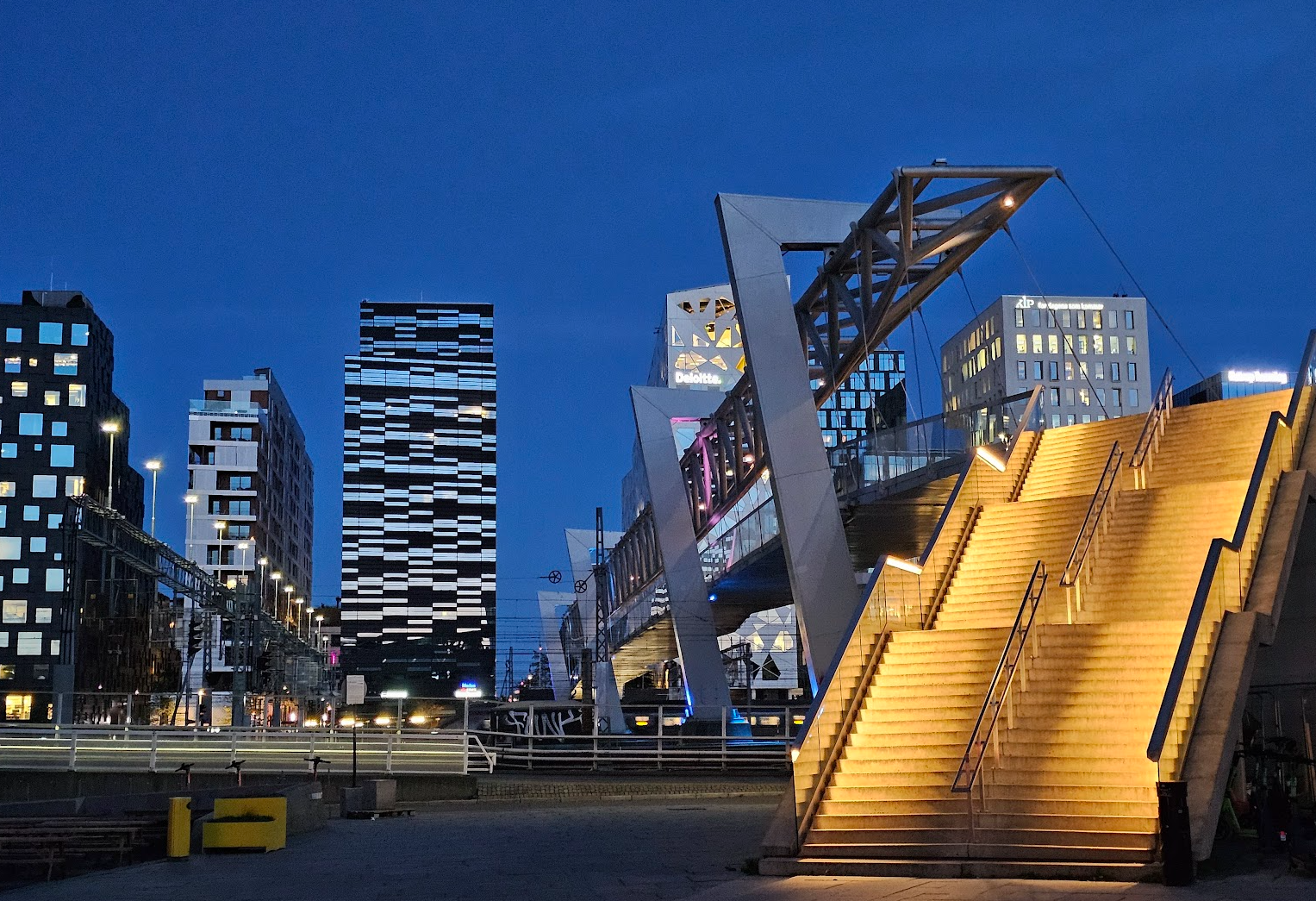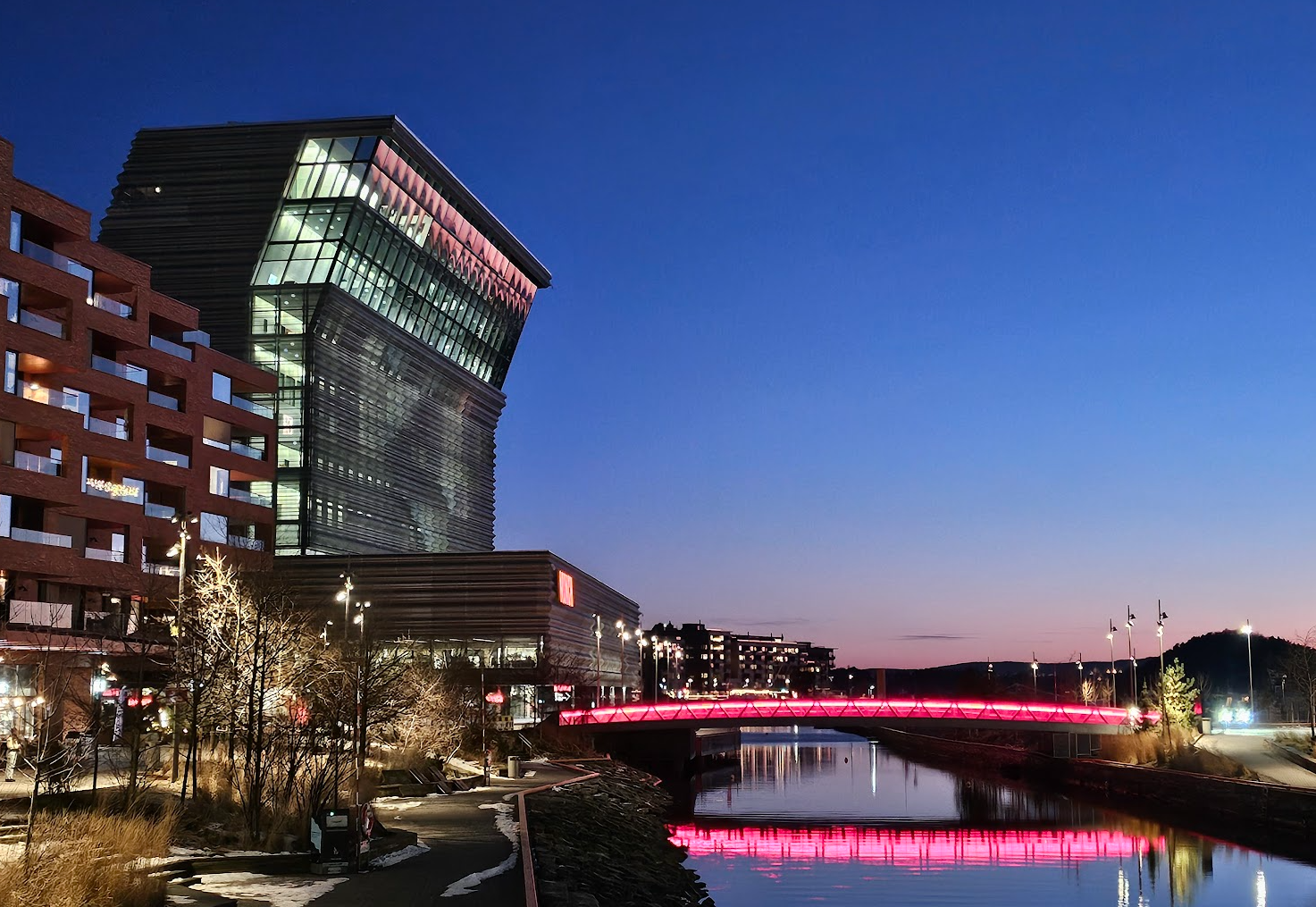Guided tours Oslo
Guided tours Oslo for every taste and budget. Explore the best of Oslo through a wide variety of guided tours—both free and ticketed.

Along with signature buildings and brand new neighbourhoods, numerous cafés, bars and restaurants have popped up in Bjørvika in recent years.
See also: Oslo on a budget
See also: Oslo fjord tour
You can also see the Oslo Fjord City as part of the Oslo Discovery Tour, read more here and book your trip here.

Oslo Opera house
The Oslo Opera House is a modern architectural landmark located in Bjørvika, right on the Oslo waterfront. Opened in 2008, it is home to the Norwegian National Opera and Ballet. Designed by the Norwegian firm Snøhetta, the building is famous for its striking white marble roof, which slopes down to the fjord and invites visitors to walk on top. With its bold design and scenic views, the Opera House is a cultural and visual highlight in Oslo.
Designed by the acclaimed Norwegian firm Snøhetta, the Oslo Opera House is a centerpiece of the waterfront. Its sloping, iceberg-like structure allows visitors to walk on its roof and enjoy panoramic views of the fjord and city.

The Deichman Library
A striking feature of Oslo's skyline, the Barcode District consists of a row of modern, high-rise buildings with unique, irregular designs. These mixed-use towers house offices, apartments, restaurants, and shops, combining functionality with architectural flair. The spaces between the buildings allow for light and air, ensuring a sense of openness despite the density.

The Barcode District
This is where your text starts. You can click here and start typing. Dicta sunt explicabo nemo enim ipsam voluptatem quia voluptas sit aspernatur aut odit aut fugit sed quia consequuntur magni dolores eos qui ratione voluptatem sequi nesciunt neque porro quisquam est.
Eos qui ratione voluptatem sequi nesciunt neque porro quisquam est qui dolorem ipsum quia dolor sit amet consectetur adipisci velit sed quia non numquam eius modi tempora incidunt ut labore et dolore magnam aliquam quaerat voluptatem ut enim ad minima veniam.

Aker Brygge and Tjuvholmen
Once industrial shipyards, these areas are now bustling neighborhoods featuring luxury apartments, fine dining, art galleries, and shops. Aker Brygge is particularly popular for its boardwalk, which offers stunning views of the Oslo Fjord. Tjuvholmen, home to the **Astrup Fearnley Museum of Modern Art**, combines cultural richness with seaside charm.
Sørenga Seawater Pool
A favorite among locals, Sørenga Seawater Pool is a public bathing facility that brings the fjord to the city. Surrounding the pool are waterfront apartments and restaurants, making it an ideal spot for relaxation and recreation.
The Oslo Fjord City project began in the early 2000s with a bold vision: to reclaim and repurpose Oslo's harborfront for public use. Historically dominated by industrial facilities and cargo terminals, the waterfront is now a thriving urban district. Stretching from Frognerkilen in the west to Sydhavna in the southeast, the development covers over 10 kilometers of coastline.
The aim was not only to improve accessibility but to create a seamless integration between the city and the fjord. With cutting-edge architecture, green spaces, and a focus on sustainability, Fjord City exemplifies modern urban planning at its best.
Oslo, the vibrant capital of Norway, is undergoing a transformation that beautifully blends urban innovation with its natural surroundings. The Oslo Fjord City project, an ambitious redevelopment of the waterfront, has turned the city's harbor area into a lively hub of culture, business, and recreation. It is a testament to Oslo's commitment to sustainable development and modern architecture, while celebrating its maritime heritage.
You can also see the Oslo Fjord City as part of the Oslo Discovery Tour, read more here and book your trip here.
See also: Akerselva river walk - journey through Oslo's urban nature
How to get there?
You can easily reach Oslo Fjord City from our Oslo Airbnb Apartments (Oslo Rentals), or you can book a guided tour. Read more about the different options here.
Guided tours Oslo for every taste and budget. Explore the best of Oslo through a wide variety of guided tours—both free and ticketed.
Cheapest Oslo accommodation with price guarantee. From 250 NOK* per night. Pricematch! If you find a cheaper option in the Area Oslo Sentrum, contact us, and we'll match the price.
Connect with an Airbnb Superhost and get $25 Airbnb credits to spend on your next trip.
See our recommended restaurants in Oslo in different categories. Most of them are located near our apartments and rooms for rent. If you have any other suggestions or comments, let us know :)
Recommended day trips from Oslo: Explore Norway's Hidden Gems. While Oslo is a vibrant and exciting city with plenty to offer, the surrounding areas boast beautiful landscapes, charming towns, and historic sites that make for perfect day trips.
Akerselva River Walk: A Journey Through Oslo's Urban Nature. The Akerselva River, often referred to as Oslo's "green lung," is an 8-kilometer-long waterway that runs through the heart of Norway's capital, stretching from Maridalsvannet in the north to the Oslofjord in the south.
Many visitors ask us How to get from Oslo Gardermoen airport to Oslo Central Station. Please note there are two airports outside Oslo, Gardermoen (main airport) and Torp. Read about the different options below, or search and buy tickets here
Find the best Oslo discounts, coupons and offers for Norway travellers and locals.
Hotels in Oslo with Free Parking: Your Guide to a Hassle-Free Trip. This article provides an overview of hotels and other accommodation options in the Oslo area that offer free parking, along with practical tips for a smoother car-based holiday.
The beautiful Oslo Botanical Gardens, located just a short walk from our Oslo airbnb apartments is a serene and enchanting green space that offers a refreshing escape from urban life.
Discover the Oslo waterfalls with our comprehensive guide. Even in Oslo there are mighty waterfalls. Here's a guide to some of the most notable Oslo waterfalls that offer unique experiences for visitors and locals.
The Vigeland Park, located in the heart of Oslo, Norway, is a renowned outdoor sculpture park and one of the city's most popular attractions. Created by the acclaimed Norwegian sculptor Gustav Vigeland (1869–1943), the park is an expansive showcase of his life's work, featuring over 200 stunning bronze and granite sculptures.

